1lumen selects and reviews products personally. We may earn affiliate commissions through our links, which help support our testing.
Fenix PD32 V2 review
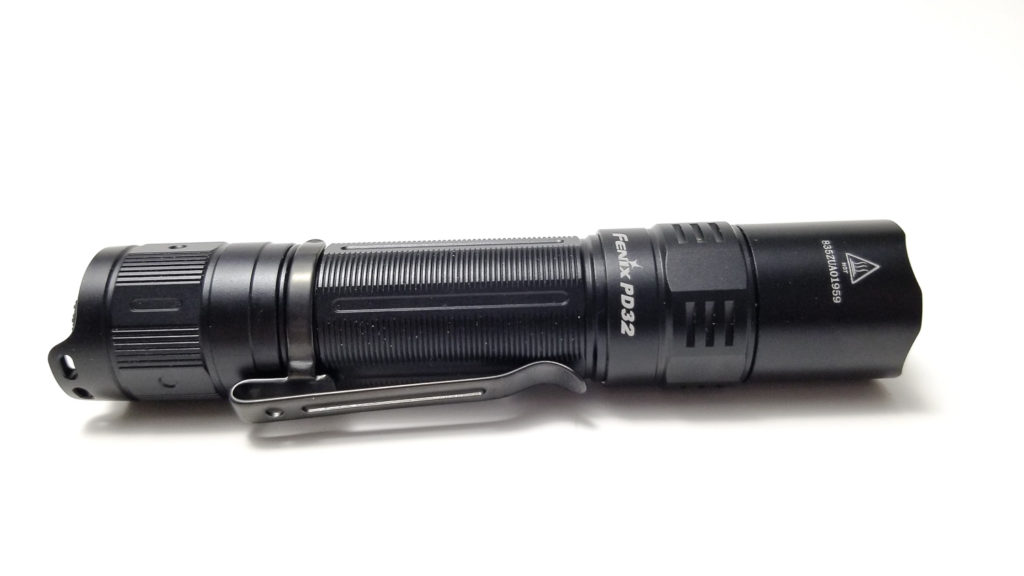
Fenix PD32 V2 specifications
| Brand/model | Fenix PD32 V2 |
|---|---|
| LED | Osram KW CSLPM1.TG |
| Max. Lumens | 1200 lm |
| Max. Beam intensity / distance | 39,000 cd |
| Battery config. | 1*18650 or 2*CR123A |
| Onboard charging | None |
| Modes | 4 |
| Blinkies | Strobe |
| Reflector | Smooth |
| Waterproof | IP68 |
| Review date | May 2022 |
Introduction:
Another Fenix on deck for today. Fenix makes a lot of flashlights and flashlight accessories, and it’s no secret that they also make some of the best lights in the industry. Moreover, Fenix has a ton of reach, with corporate offices in the US and abroad. Here in the USA, they’re run under the company Open Air Brands, LLC. That’s good for flashlight enthusiasts and professionals who want the best of the best in portable lighting. One of the perks of being on top is the ability to sink capital into research and development, which means existing lights get better over time. Although Fenix lights age well, the nature of the industry demands new and improved products, and the light I’ll be taking a look at today is another version 2.0 of an existing light, the PD32. Introduced in 2016 as a single 18650 EDC light and part of Fenix’s PD line of smaller size duty and EDC-oriented lights. With 900 Turbo Lumens on tap, for the time, it was pretty powerful, but alas, 2016 was a long time ago, and it was time for an update. Enter the V2. It’s brighter, has a simpler UI, and a new switch arrangement. Let’s see how it stacks up. So far, I’ve always been impressed with Fenix’s upgrades.
Package quality.
The PD32 V2 comes in a retail-friendly package because (just like every other Fenix light) these are sold in stores at bigger sporting goods retailers and specialty shops. It’s got the typical specs and feature blurbs, orange and black graphics and photos. Nothing super-special. The light was riding in the typical thin plastic carrier with the accessories underneath. Here’s what’s inside.
- Fenix PD32 V2
- Manual
- Warranty card
- Lanyard
- Holster
- Spare o-ring
Overall, this is what I expect from Fenix, except this time it’s missing an important RTR (ready-to-run) item, namely, a battery. Yep, no battery with the PD32 V2, and that’s a problem if you don’t have a button top or protected flat top 18650 or two CR123A batteries. On top of that, you’ll need a li-ion charger or an 18650 with built-in charging (read on for why). You do get everything else though and the accessories seem a bit cheaper than other Fenix lights I’ve tested and you only get a single o-ring this time. C’mon Fenix, give a guy a couple o-rings, please.
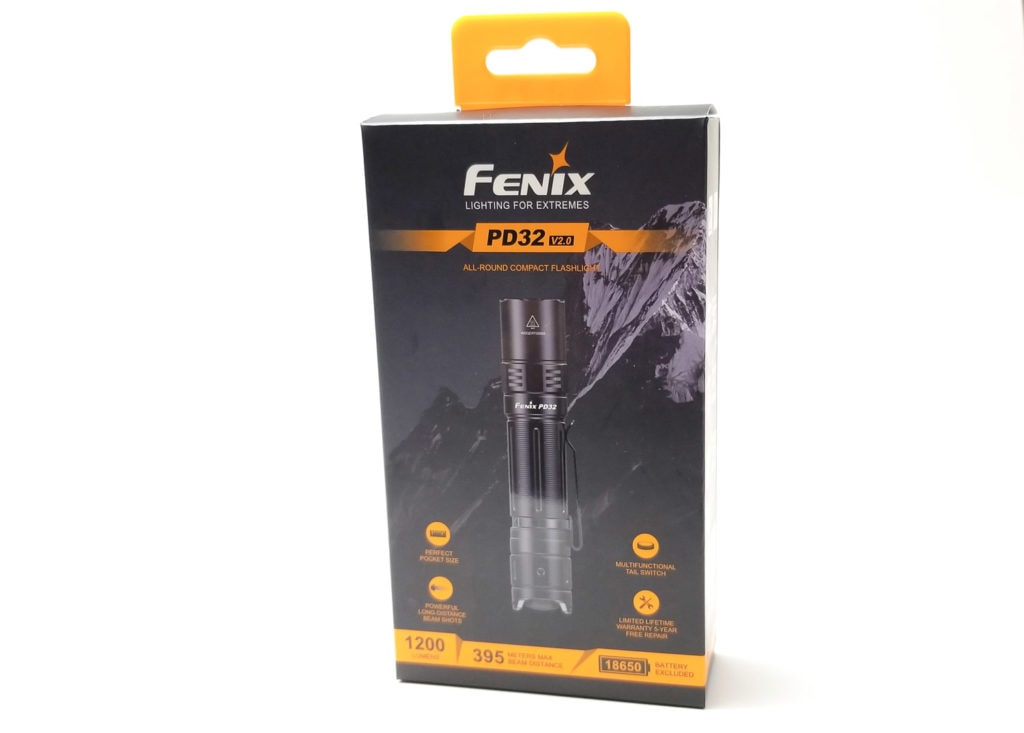
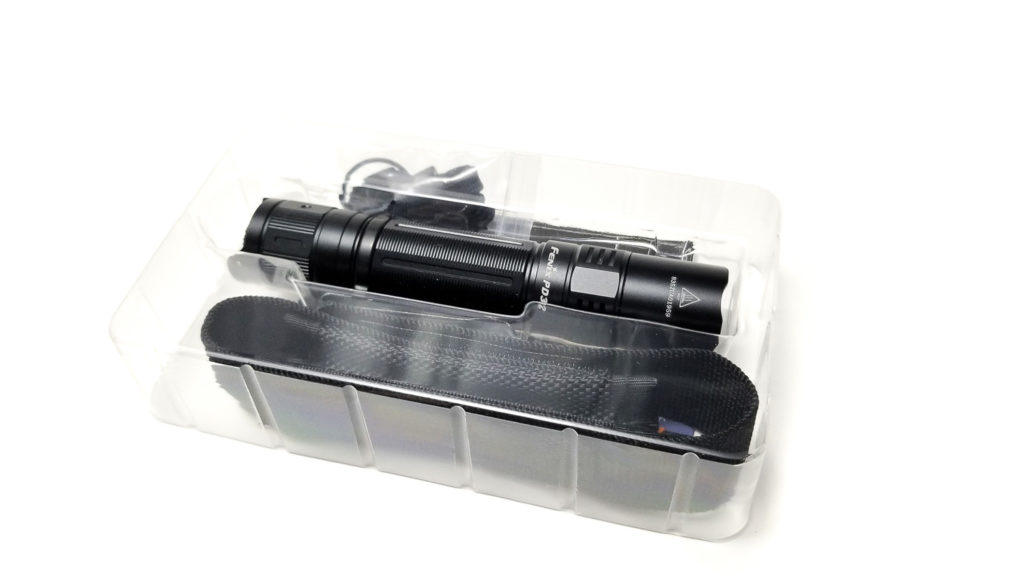
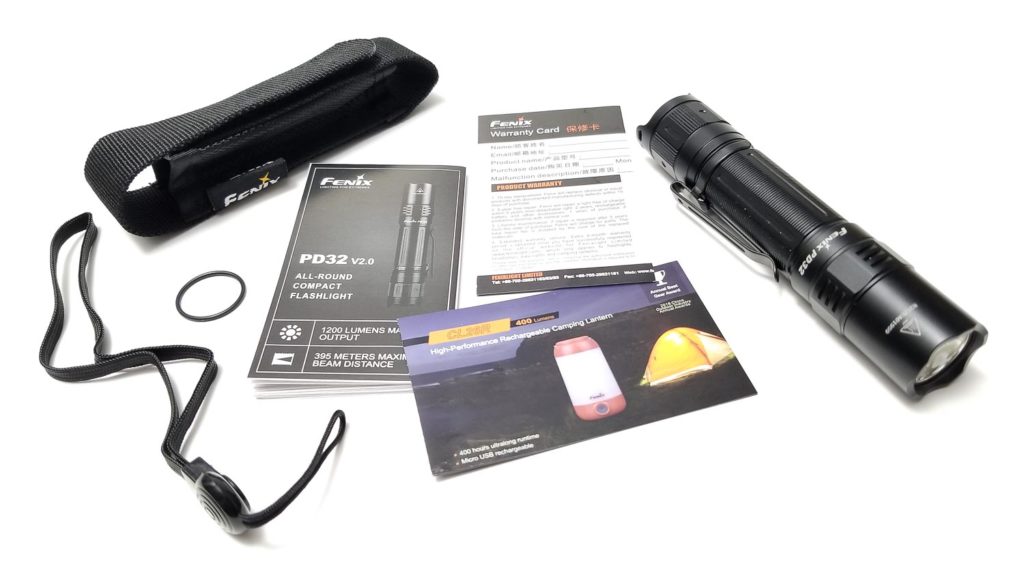
Flashlight in use
The PD32 V2 is an EDC (every day carry) light and its main role is pocket carry, but of course, it can ride in a tool box, clipped to a belt (in the holster), or hang from the lanyard. It would be a very nice backup light as well. It’s a very versatile light and lends itself to a variety of tasks. It handles about like any other 18650 size light would. The battery tube is slender, and it fills out the hand nicely. It’s roughly the same size as the Sofirn SC31T. The 2016 PD32 had a clicky switch at the tail and an e-switch up front, but the V2 only has a single rear e-switch that pretends to be a forward clicky switch, and this lends itself to overhand carry more than underhand. I found it easy to maneuver and point, and it’s very nicely balanced. Even with a battery loaded, it’s still very light for being a bit long, well under 100 grams.
The switch is unique in that it operates like a forward switch, so you get momentary functionality by tapping it and continuous operation by fully depressing and releasing the switch. It’s an odd-feeling switch in that it doesn’t click like a traditional clicky and there’s minimal tactile or audible feedback. It feels almost exactly like the switch on the Acebeam L17, and I wasn’t a fan of that one. The benefit is it’s silent, but I don’t like the lack of feedback. The travel is also pretty long and this makes it feel vague and mushy.
The pocket clip is blackened steel or stainless steel, and it’s not exactly a deep carry clip, but it’s a bit deeper than other Fenix clips I’ve used. The clip can be detached as well. There’s two lanyard mounting points on the tailcap’s ears that protect the tail switch and helps your thumb rest on the switch. The holes are nicely sized and the lanyard threaded easily. Tail standing? Sort of. It’s iffy and about as stable as Charlie Sheen’s relationships.
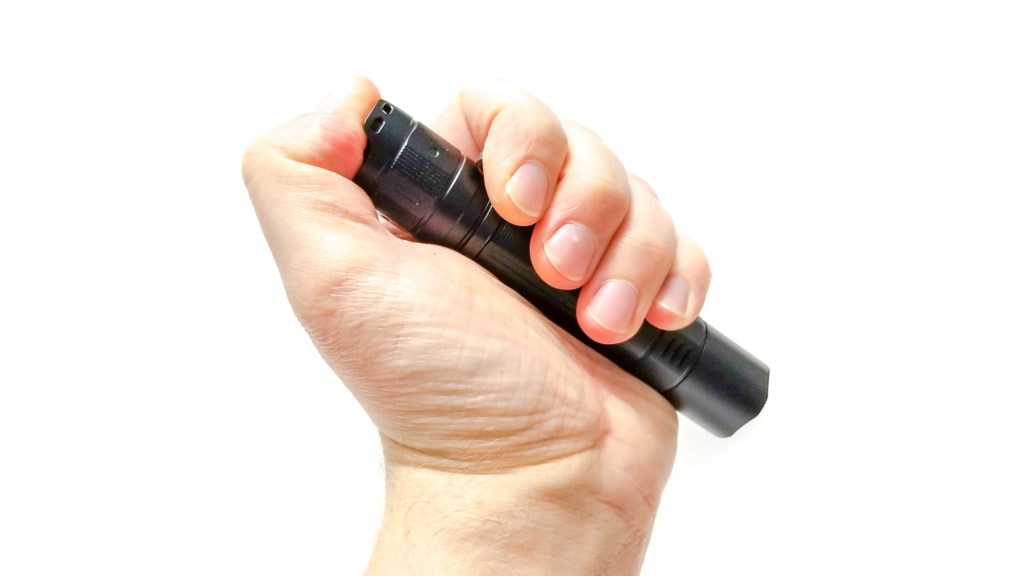
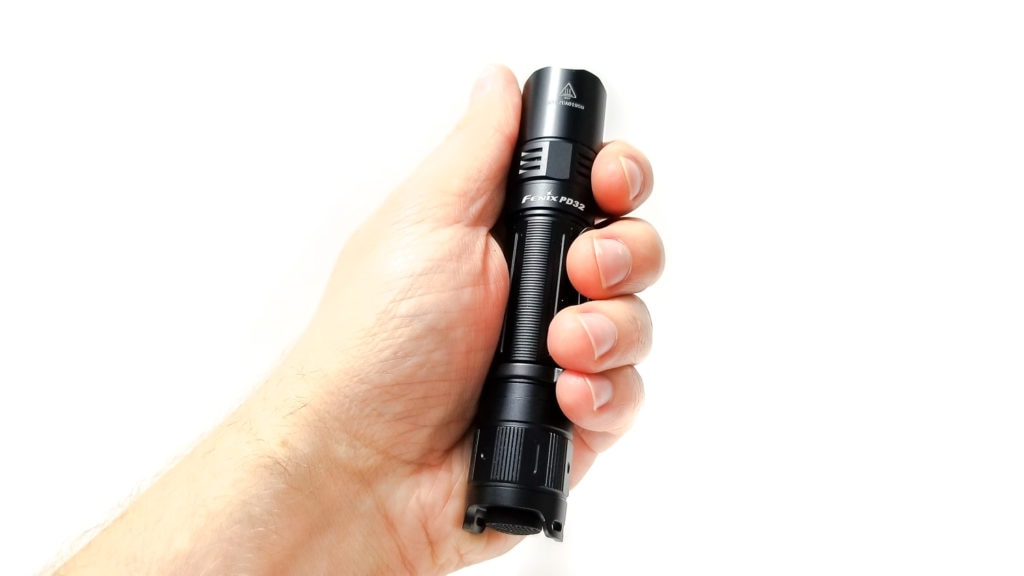
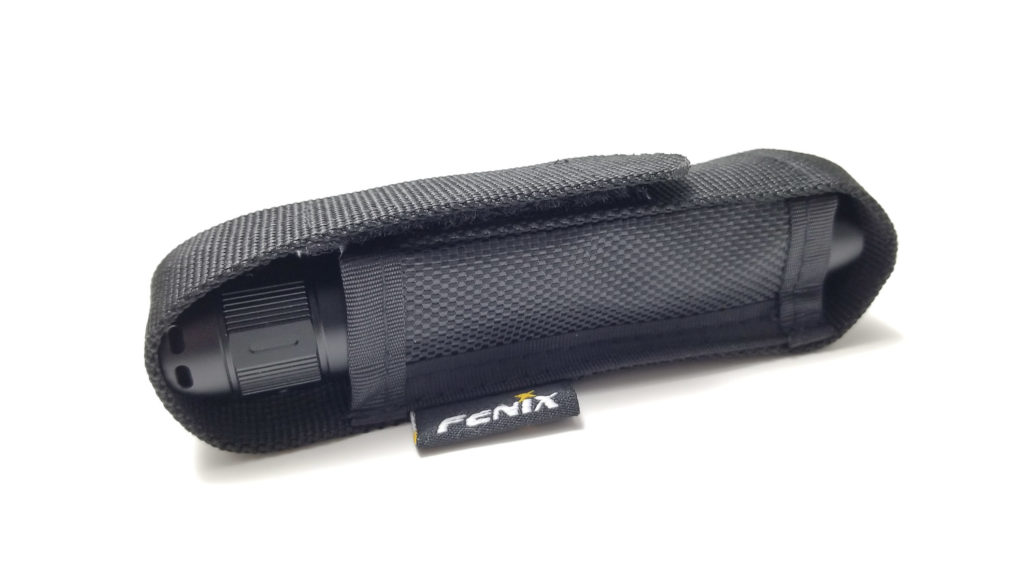
Build Quality, and Warranty
Anyone who has ever owned a Fenix light knows they’re very high-quality items, like a premium hand tool. The PD32 V2 is no exception, and although it’s the low-man on the totem pole on the PD series, it’s no less high quality. Unfortunately, it has a high quality price as well (maybe a bit too high) at about $65 US.
The light is milled from 6061-T6 aluminum, and the machining is super-tidy, with no machine or tool marks, no blemishes, and every edge has been knocked down and smoothed. This is good for preventing hang-ups when drawing from the pocket. The silk screen text is super sharp as well, and all the parts fit together perfectly. The finish is the typical Fenix semi-gloss type III HA anodizing and it’s very high quality and durable. My other Fenix lights get knocked around sometimes, and they’re holding up great.
The only removable part is the tailcap, which has fully anodized (for mechanical lockout), large, and very precisely machined rectangular threads. They don’t seem lubed, but maybe it’s graphite lube? They were still super-smooth nonetheless. For springs, you only get one this time on the tailcap. It’s decently thick and gold plated. The driver-side has a flat brass contact with two interference bars on either side for reverse polarity protection. There’s a single o-ring sealing the tailcap, and with no external charge port, it’s rated for a proper IP68 water resistance.
Warranty? One of the best out there with support in the US and abroad: Fenix Lighting US, guarantees all Fenix products purchased from retailers to be made of first-class materials and therefore provides a lifetime warranty against any defects in material and workmanship. Excluded from warranty coverage is any damage to the exterior deemed reasonable wear and tear such as scratches and/or fading of color. In addition, the warranty does not apply to damage caused by abnormal or unreasonable use of any of the components. This includes use of unapproved batteries in Fenix products.
This warranty is in place of all other warranties, including warranty of fitness for a particular purpose and warranty of merchantability and excludes any liability for incidental or consequential damages. If your Fenix product has a manufacturer’s defect covered by our warranty, we will either repair or replace it, at our option, without charge. Most damaged Fenix products not covered by the warranty can still be repaired. If repair costs and handling charges apply, you will be notified prior to any service. All warranty repairs or replacements are at the sole discretion of the Fenix Lighting US Authorized Repair Center and we reserve the right to refuse a request.
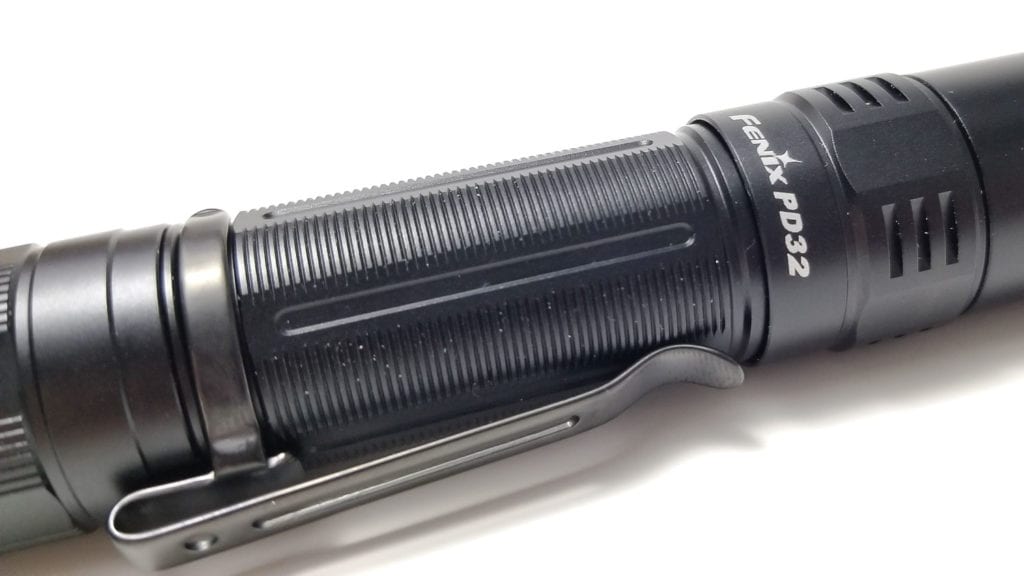
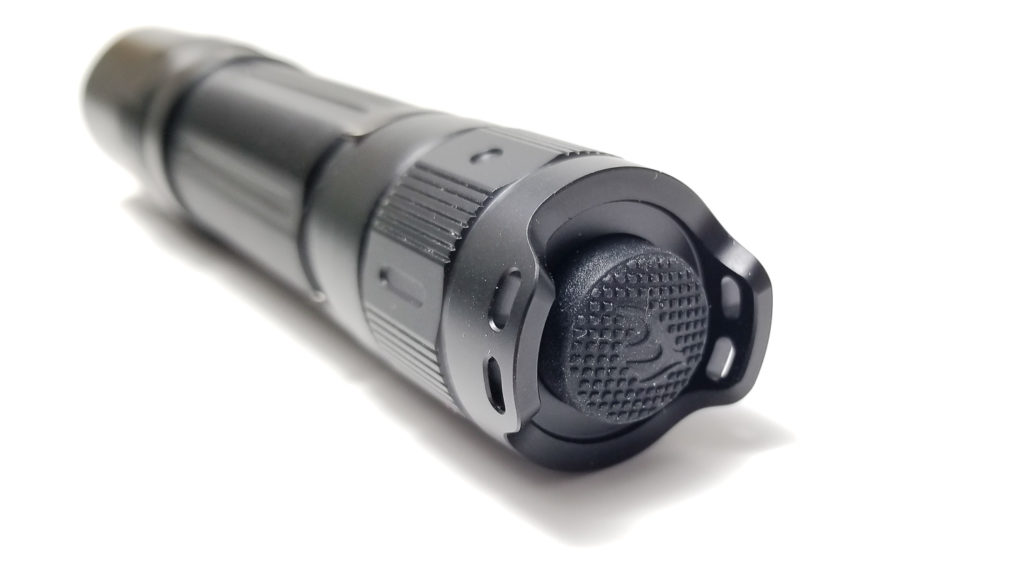
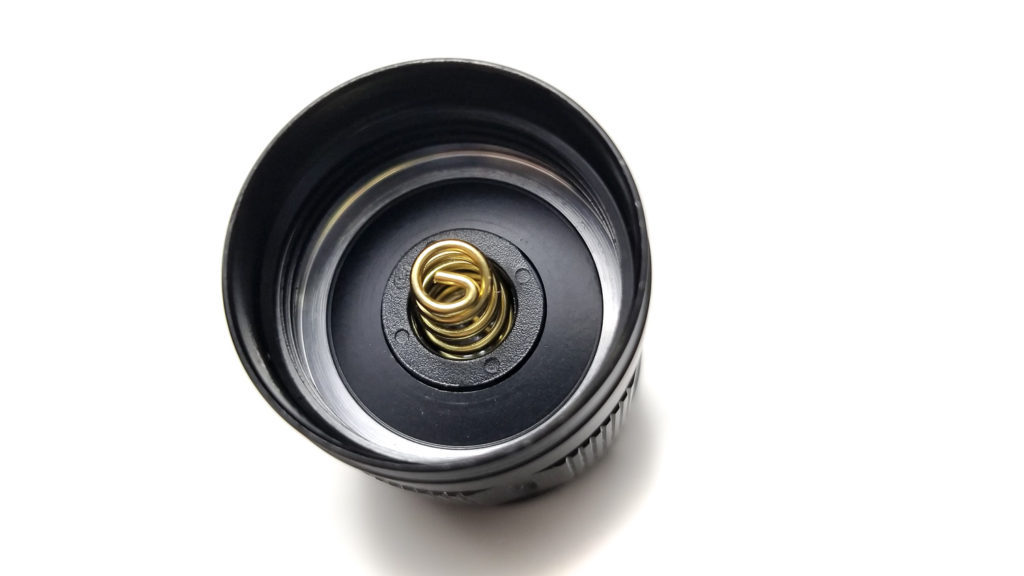
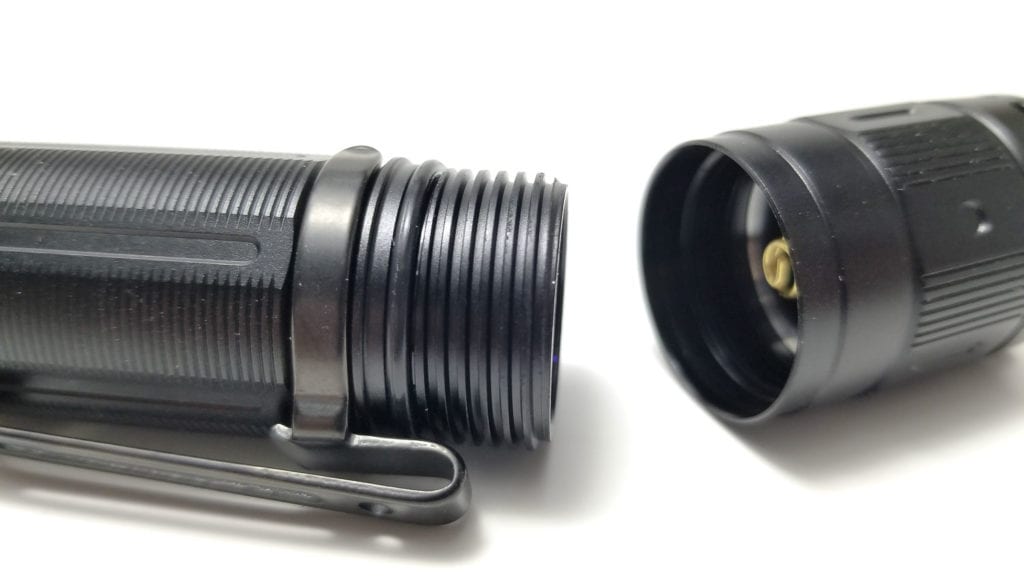
LED, Lens, Bezel, Beam, and Reflector
Fenix doesn’t conceal the identity of the LEDs they use, which I think is nice for consumers. The original PD32 featured a Cree XP-L HI LED and this was a good emitter in 2016, and it holds its own today, but there are better choices available. Surprisingly, Fenix didn’t use the obvious choice here, the Luminus SFT-40-W, but went with the other domeless high-intensity emitter, the old faithful Osram Ostar KW CSLPM1.TG, aka W2.
This emitter has been featured in tons of enthusiast lights and some consumer lights as well (both the Acebeam L17 and L18 have it) for good reason. It’s efficient, has great intensity for good throw in smaller lights, and the 3mm x 3mm footprint fits well in smaller reflectors and heads. The LES is rectangular, and measures 1.83 mm2, so you get very good cd/mm2 and decent throw even in smaller reflectors. It’s down on output compared to the XP-L HI and SFT-40-W, so it won’t win any Lumen awards, but holds its own nonetheless, and more importantly is brighter than the previous light. No tint is specified, but we all know the CSLPM1 comes in any tint you want as long as it’s cool white, and the Opple Lightmaster Pro agrees, with the tint coming in at 6044K and 65.9 Ra. The duv is 0.0047.
The bezel extends pretty far down the side of the head, and it’s crenulated, but I don’t think it’s a strike bezel. The AR coated toughened mineral glass lens is set back from the edge of the bezel a good 3 mm, so it’s well-protected from drops. The beam is nicely tuned for an EDC or general purpose light like this, so there’s some generous spill with a bright good-sized hotspot. There’s the typical focusing anomalies consistent with the W2 emitter present here; a fuzzy bright corona that fades into the spill For a 25 mm diameter head, this thing has plenty of reach and is properly bright. It’s not as bright as a Lumintop FWAA or FW3A, but has much better throw.
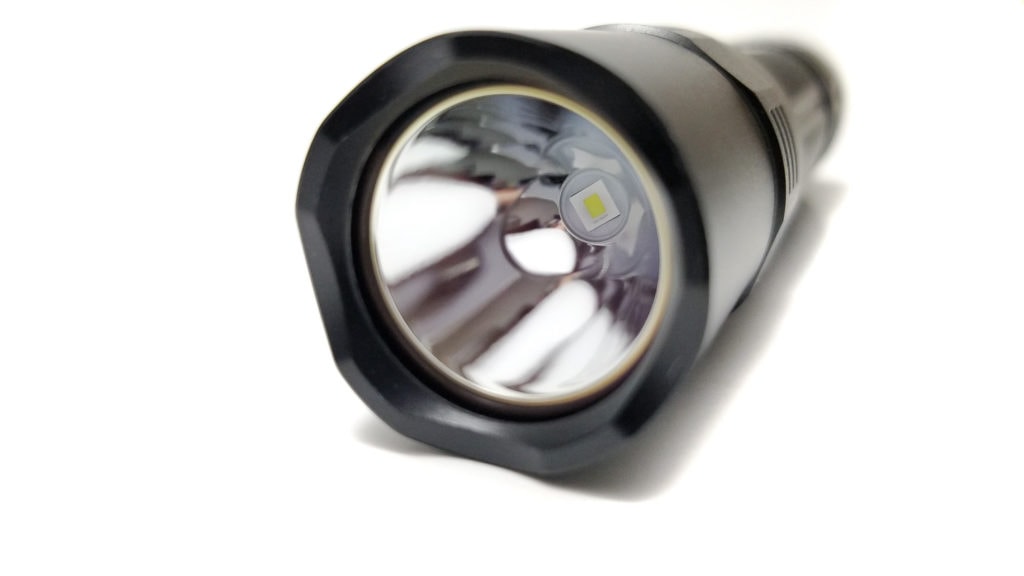
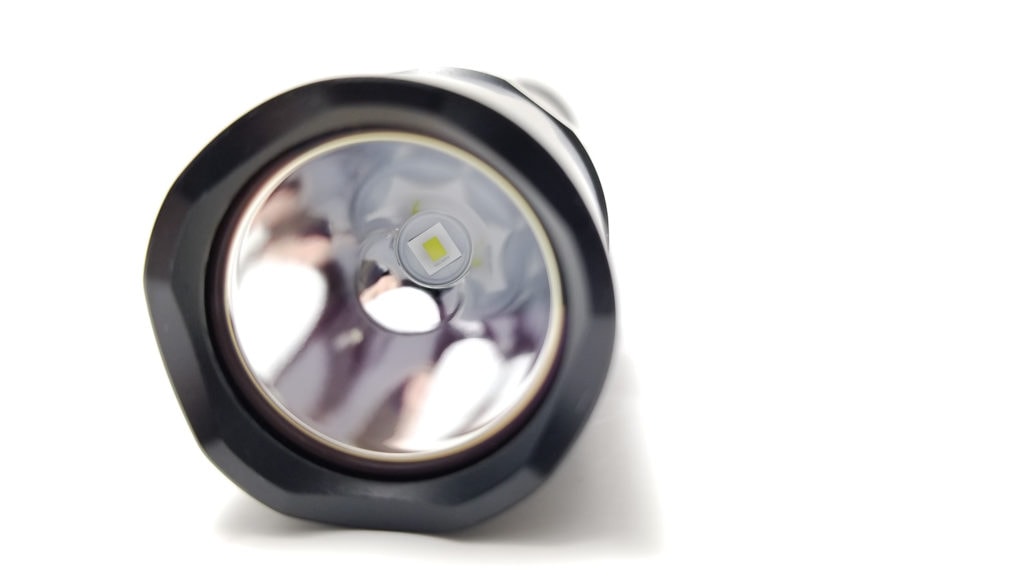
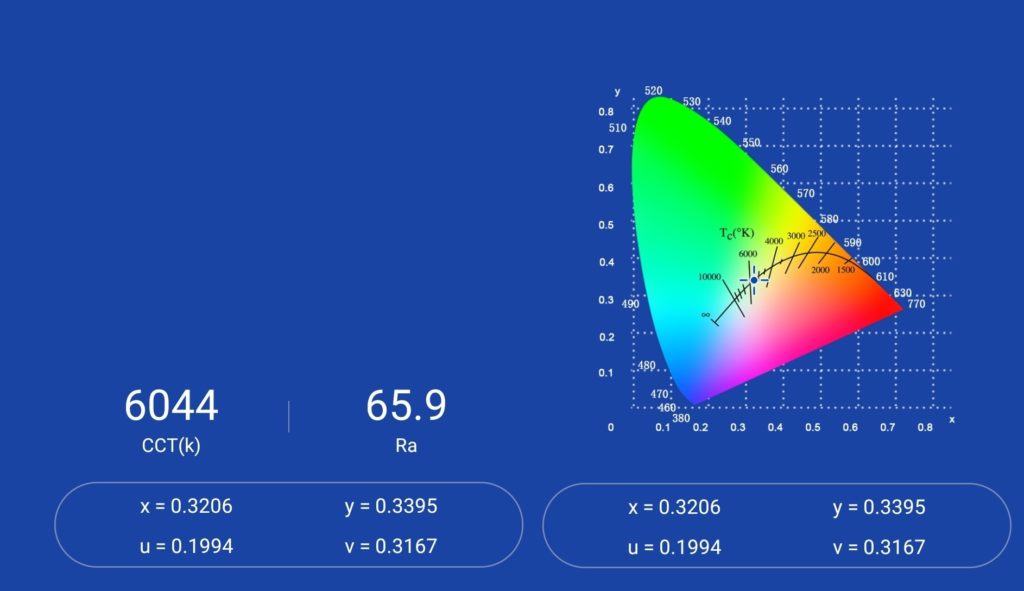
Dimensions and size comparison
- Length: 12.94 cm / 5.09 inches
- Head diameter: 2.54 cm / 1 inches
- Body diameter: 2.36 cm / 0.93 inches
Weight:
- With Fenix ARB-18L-2600U battery: 130.5 grams / 4.60 oz
- Without battery: grams 81.5 grams / 2.87 oz
EDC Flashlight comparison
I compared the PD32 V2 to some other EDC type lights
Group 1 left to right: Fenix E09R, Lumintop FWAA, Fenix PD32 V2, Wuben D1, Sofirn SP10 V3
Group 2 left to right: Sofirn SC31T, Fenix PD32 V2, Fenix PD36 Tac, Fenix PD35 V3
Group 3 left to right: Thorfire C8, Fenix PD32 V2, Fenix PD35 V3
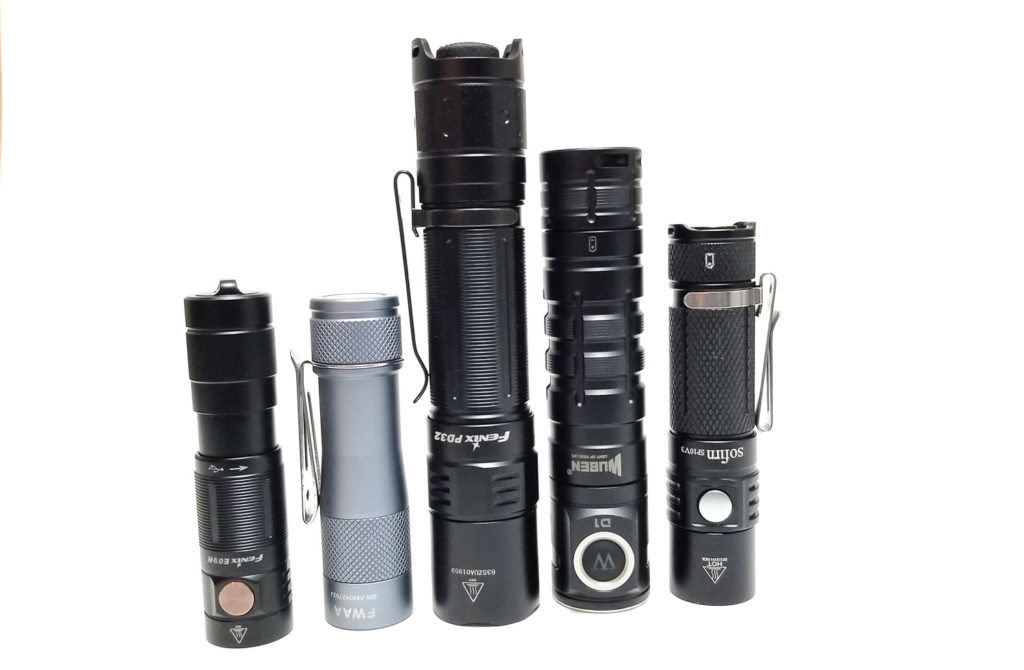
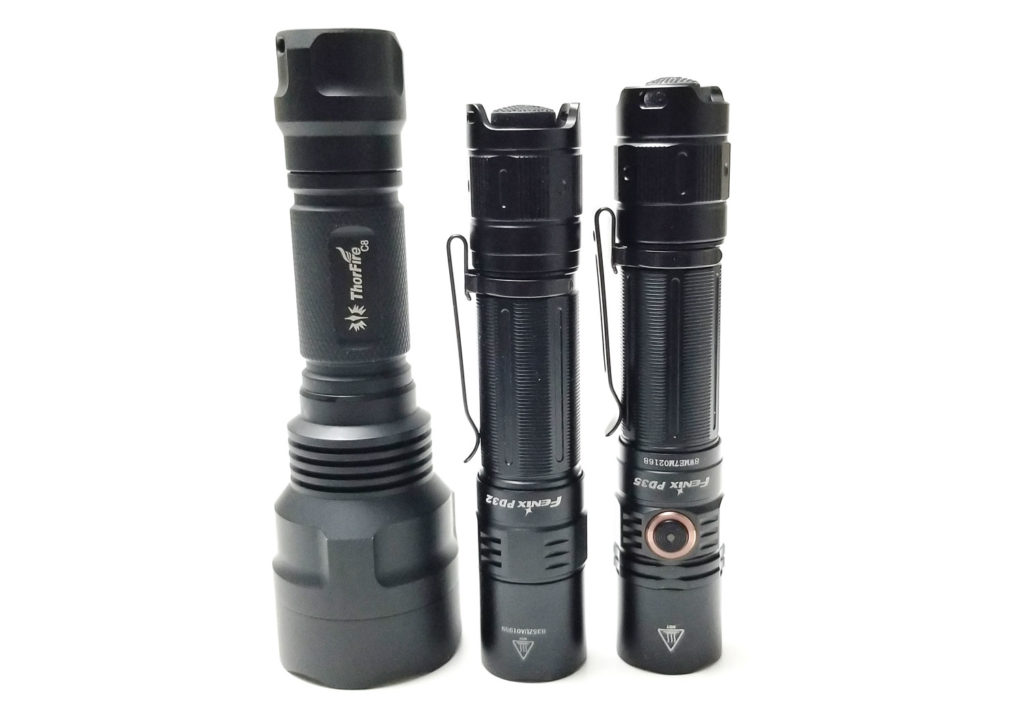
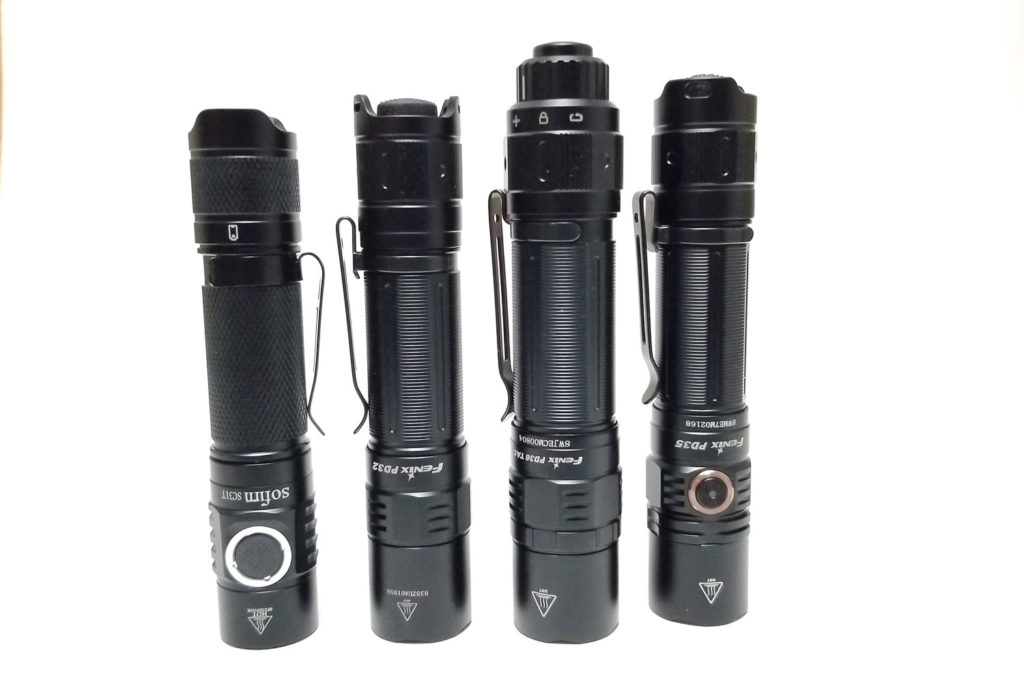
Driver & User Interface:
I don’t know the exact driver Fenix has stuffed into the PD32 V2, but since it can take 2 CR123 batteries, it’s most likely a buck driver, but the runtime test will tell!
The V2 UI has been changed a bit from the first version. The PD32 originally had 5 regular modes and 2 blinkies, but the V2 has 3 regular modes and a lone Strobe. You know me, I like simple, and I’m thrilled to see a V2 light with a simpler UI. .
Available modes: Low, Medium, High, Strobe.
From OFF:
- Press and hold switch: Fully pressing and holding for more than ½ second activates Strobe
- Single click switch: Activates continuous operation
- Tap switch: Momentary on in last mode
From ON:
- Press and hold switch: Fully pressing and holding for more than ½ second activates Strobe
- Single click switch: Fully pressing and releasing the switch turns off
- Tap switch: Cycles through modes L-M-H
Mode memory
- Yes, remembers the last used mode when switched off
Shortcuts:
- Press and holding the switch when on or off for ½ second will activate Strobe.
Low voltage warning:
- Yes. When the battery gets low, the brightness steps down to Low mode and the light will blink 3 times every 5 minutes until shut down.
Strobe/blinkies
- Yes, Strobe
Lock-out mode:
- None, but the light can be locked out by unscrewing the tailcap 1/8 turn
PWM
- None and not visible by camera
Additional info on the UI:
- Once again, I’m glad to see a simple UI on the other end of the tail switch. I’ve said it before, and I’ll say it again: complicated UIs have their place, and enthusiasts love them, but for the rest of the flashlight-consuming and carrying population, simple UIs are just fine and get the job done. The PD32 V2 UI includes all the niceties we come to expect from a premium flashlight brand: Mode memory, nice mode spacing, LVP, ATR, and a nicely-regulated constant-current driver. It’s nice to see visual LVP since there’s no switch or external indicator, but even then, I still prefer a visual LVP indicator. It’s perfect for an EDC light as well, even though there’s no Turbo mode, I don’t think it needs it since the High mode is properly bright.
Batteries & Charging
Here’s one area I think the PD32 V2 is lacking a bit. I usually don’t bash lights too much for battery issues, but I will here. The PD32 V2 retains the 18650 size form factor, and can alternatively use two CR123A batteries in a pinch, but by default it’s an 18650 light. Fenix doesn’t include a battery with this one, and that’s a bit odd for a nearly $70 flashlight, and it’s the first Fenix I’ve tested that doesn’t include one and that’s an issue because you can’t pop just any 18650 in here.
It needs at least a button top. I tried a VTC6 and 18650GA (which have a slightly raised positive contact), and both were too short. However, a button top Sofirn 3000 mAh 18650 worked, and so did the 3100 mAh button top from the Thrunite TC15 V3. Of course the Fenix ARB-L18-2600U I nipped from the Fenix PD35 V3 also worked fine, as did the Wuben 18650 with USB C charging and Acebeam 3100 mAh button top with USB charging.
Unless you have some button top 18650s or plan to use oodles of CR123As, you’ll be out of luck, Chuck. Although CR123As are a good option, unless your employer provides them, they get expensive quickly. I paid about $9 for a 2 pack. If you run 18650s, there’s another potential issue and that’s because the PD32 V2 doesn’t have onboard charging. Yep, it’s 2022 and this consumer-oriented light has no onboard charging. This is an issue because cheaper competitors have onboard charging standard, or at the least include a battery with onboard charging like the Wuben D1. Fenix does sell quite a few 18650s with built-in charging, the cheapest being the 2600 mAh ARB-L18-2600U for about $12, up to $25 for the flagship 3500 mAh ARB-L18-3500U. If you go that route, you just boosted the price of the PD32 V2 to almost $100. If you bring-your-own-battery, you’ll need a charger for it, and fortunately, they can be had for about $10-$20 for a decent one.
Fenix, please include an 18650 with USB charging with this light.
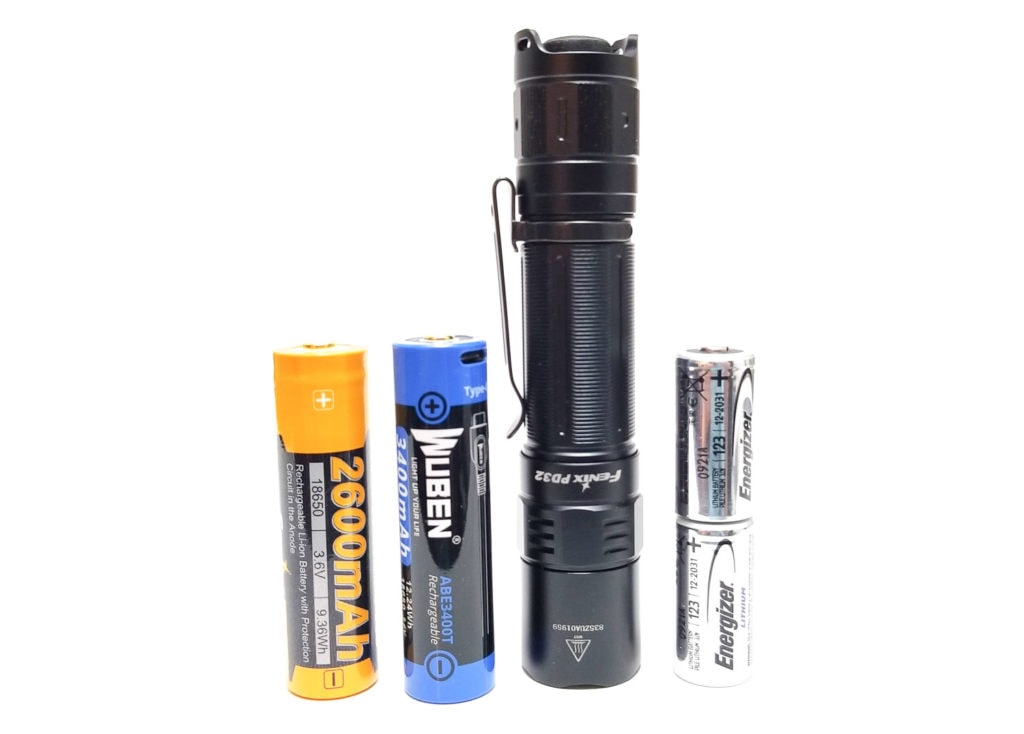
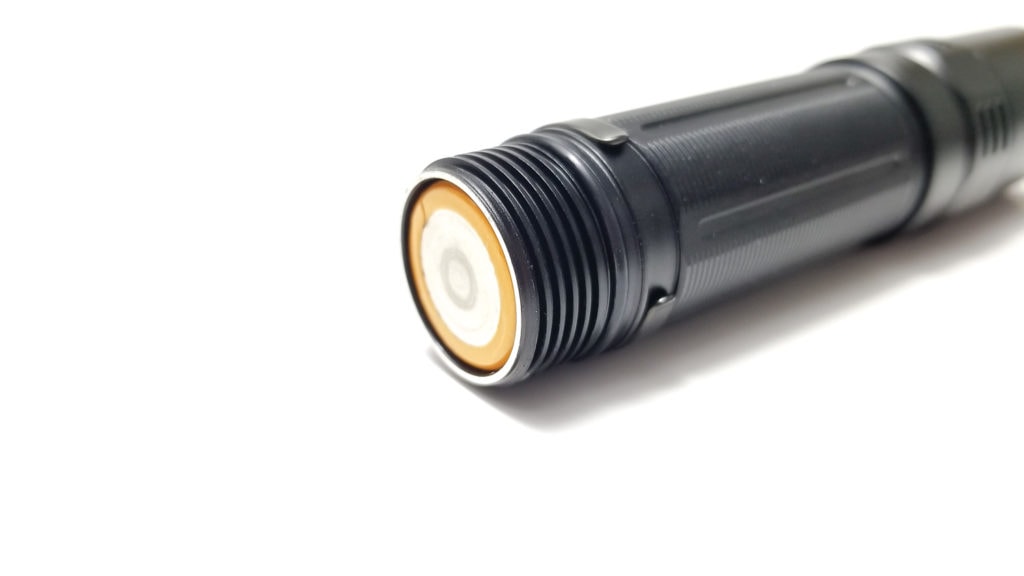
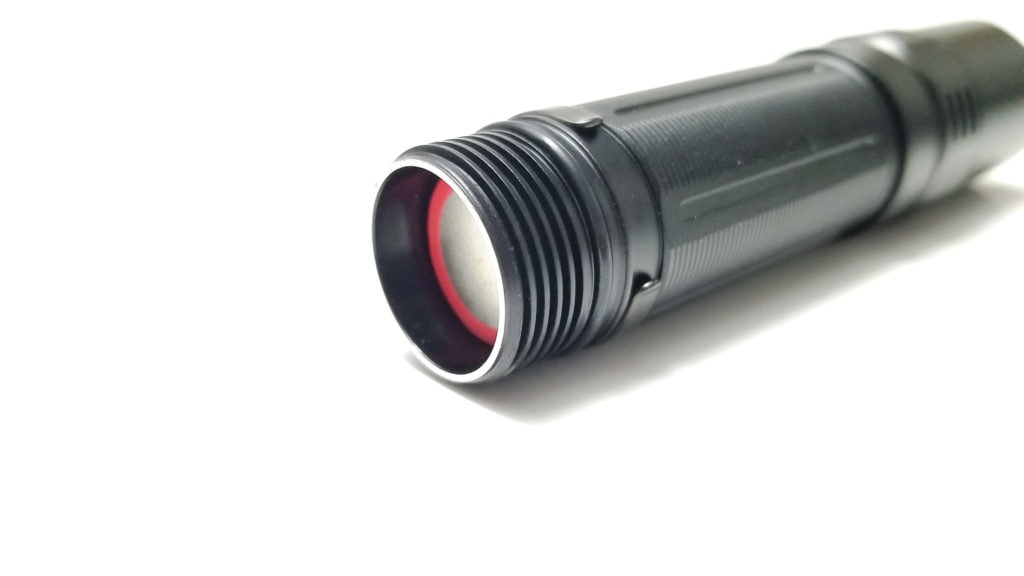
Performance test
Lumen measurements (for each mode)
Lumens are measured using my home made 30 cm integrating sphere, and I use a Digi-Sense 20250-00 datalogging luxmeter. The sphere has been calibrated using many lights of known output, including a Makkua calibrated Convoy S2+. All measurements taken at 30 seconds with a fully charged Fenix ARB-L18-2600U 2600 mAh 18650. Due to the design of the rear switch, I could only get a single amp reading for the High setting.
| Mode | Amps at start | Specs | turn on | 30 sec | 10 minutes |
|---|---|---|---|---|---|
| Low | ? | 30 | 39 lm | 39 lm | 39 lm |
| Med | ? | 350 | 312 lm | 310 lm | 300 lm |
| High | 4.80 A | 1200 | 1004 lm | 938 lm | 398v |
Parasitic drain:
- 2.3 µA nice and low!
Runtime graph
I tested the runtimes in the 30 cm integrating sphere using the Digi-Sense 20250-00 datalogging luxmeter using the Fenix ARB-L18-2600U battery. I tested Low, Medium and High modes.
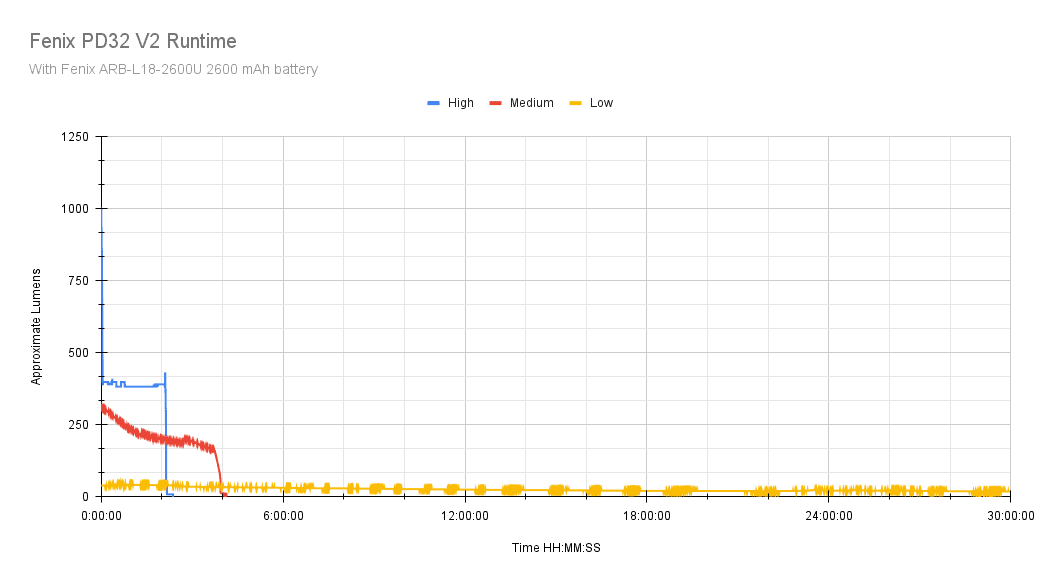
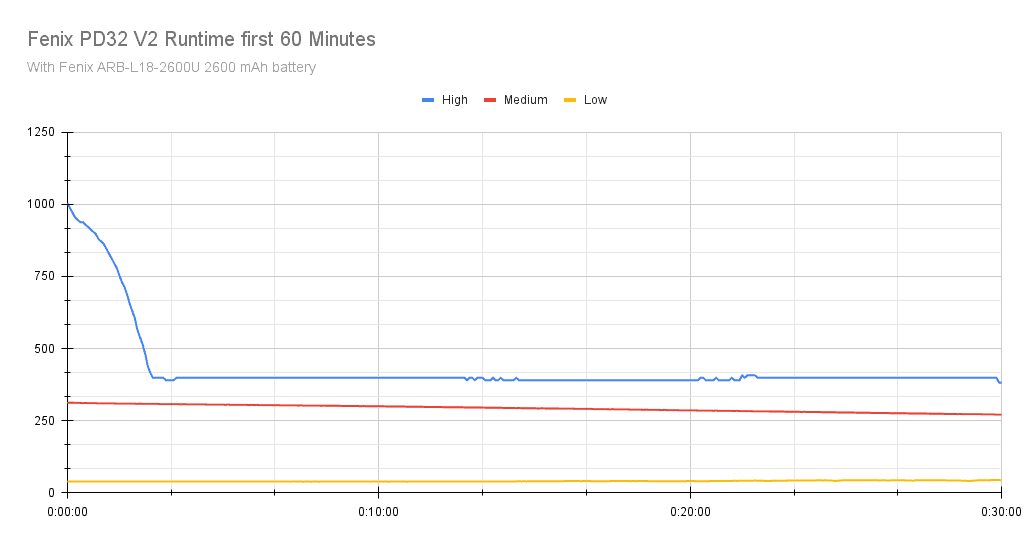
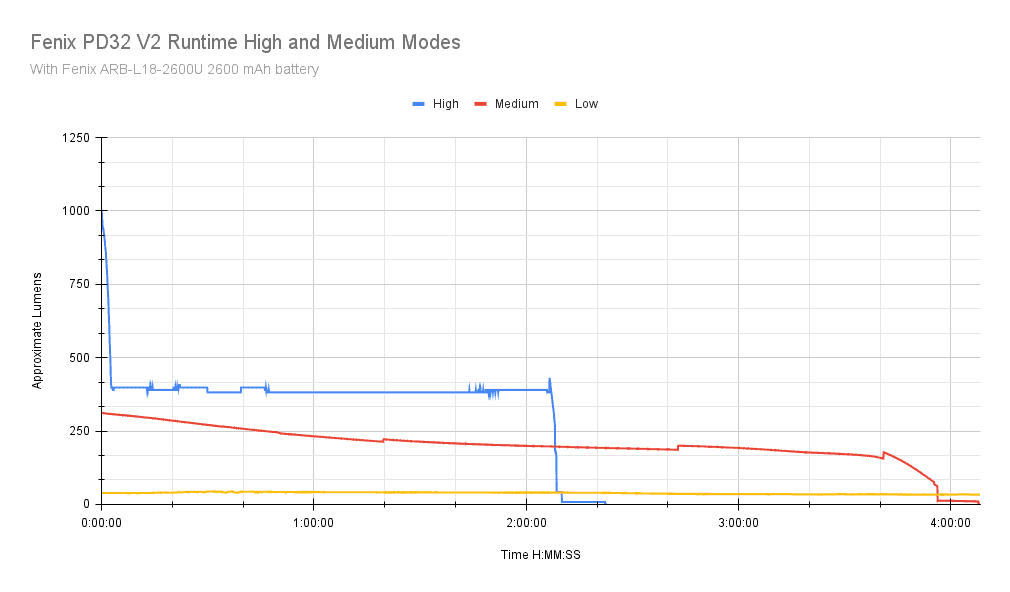
High mode started at 1004 Lumens, so down a bit from spec, but still respectable for a small tube light. The output slowly declined over the first 3 or so minutes, but holding over 500 Lumens for almost 2 minutes 30 seconds. Not bad. However, around the 3 minute mark, it’s all over, with the output settling at 398 Lumens. Over the next 2 hours, the output is consistent between 380 and 390 Lumens until the 2 hour 7 minute mark when the output dropped off sharply as LVP pulled it down. The output stayed steady for 2 minutes until 2 hours 10 minutes in when it dropped very low and shut down at 2 hours 22 minutes. Fenix specs 2 hours 40 minutes for the High runtime, but I suspect they’re using a high capacity battery (maybe the 3500 mAh one) whereas I’m using a 2600 mAh one. Heat is not an issue during the test, with consistent thermal management, but it did heat up quick: From 21 ambient to 43 C in just 10 seconds, to a max of 50.9 C by 30 minutes in. The light was hand safe for the entire runtime though. The battery measured 2.9 volts at the end of the test, and the light was not usable.
Medium was pretty boring, starting at 312 Lumens, and holding better than 300 Lumens for about 10 minutes before slowly dropping off in a non-linear manner. The output stays pretty consistent for the next 4 hours at 200 Lumens or better. Towards the end of the runtime, the light behaves similarly to the High test, with the first big step down happening at 3 hours 56 minutes in, down to about 12 Lumens, which it held for the next 11 minutes in a gradual taper down until shut down at 4 hours 7 minutes 50 seconds. Heat wasn’t an issue, with the highest reading at 45.3 C at 30 minutes in. The light was still completely useable after the test, with all modes available. Fenix specs 5 hours 20 minutes for the runtime, and not surprising, I’m coming in under that.
Low was the obvious endurance winner here. This is the longest runtime test I’ve ever run, and I actually ended the test after 34 hours. I included the first 30 hours in the test since it keeps the graph tidy, but this is impressive for a 2600 mAh battery. The test started at a hair under 40 Lumens, and held better than 30 Lumens for almost 7 hours. The output was pretty consistent, but not linear and behaved like Medium. When the output dropped under 20 Lumens by 27 hours, I let it run for another 3 hours before ending the test. The output was still about 18 Lumens. Fenix says the light runs for 82 hours on the high capacity battery, so if I let it run, it would probably run for 3 days straight. Even after the test, there’s still plenty of runtime left since the battery was sitting right at 3.5 volts.
It looks to be a buck driver at work here, even though the Medium and Low runtimes aren’t completely linear, these are still very good runtimes for a 2600 mAh battery and evidence of a nicely-regulated driver well matched to the LED. The thermal regulation is also very good with no spikes or sawtooth behavior.
Throw numbers:
Throw was measured using the Uni-T 383S luxmeter at 5 meters indoors. Readings taken at 30 seconds and I used the same ARB-L18-2600U battery.
| Mode | Specs | Candela measured | Meters | Yards |
|---|---|---|---|---|
| Low | 760 cd | 1325 cd | 73 | 80 |
| Medium | 11,900 cd | 12,575 cd | 224 | 245 |
| High | 39,000 cd | 29,775 cd (38,775 at start) | 345 (394 at start) | 377 (431 at start) |
Beamshots
I compared the PD32 V2 to similar lights including the:
- Sofirn SC31T
- Fenix PD35 V3
- Fenix TK16 V2
- Wuben D1
- Wuben C2
- Acebeam P15 Defender
- Fenix PD36 Tac
- Klarus XT11GT Pro V2
The fence is about 95 meters away.

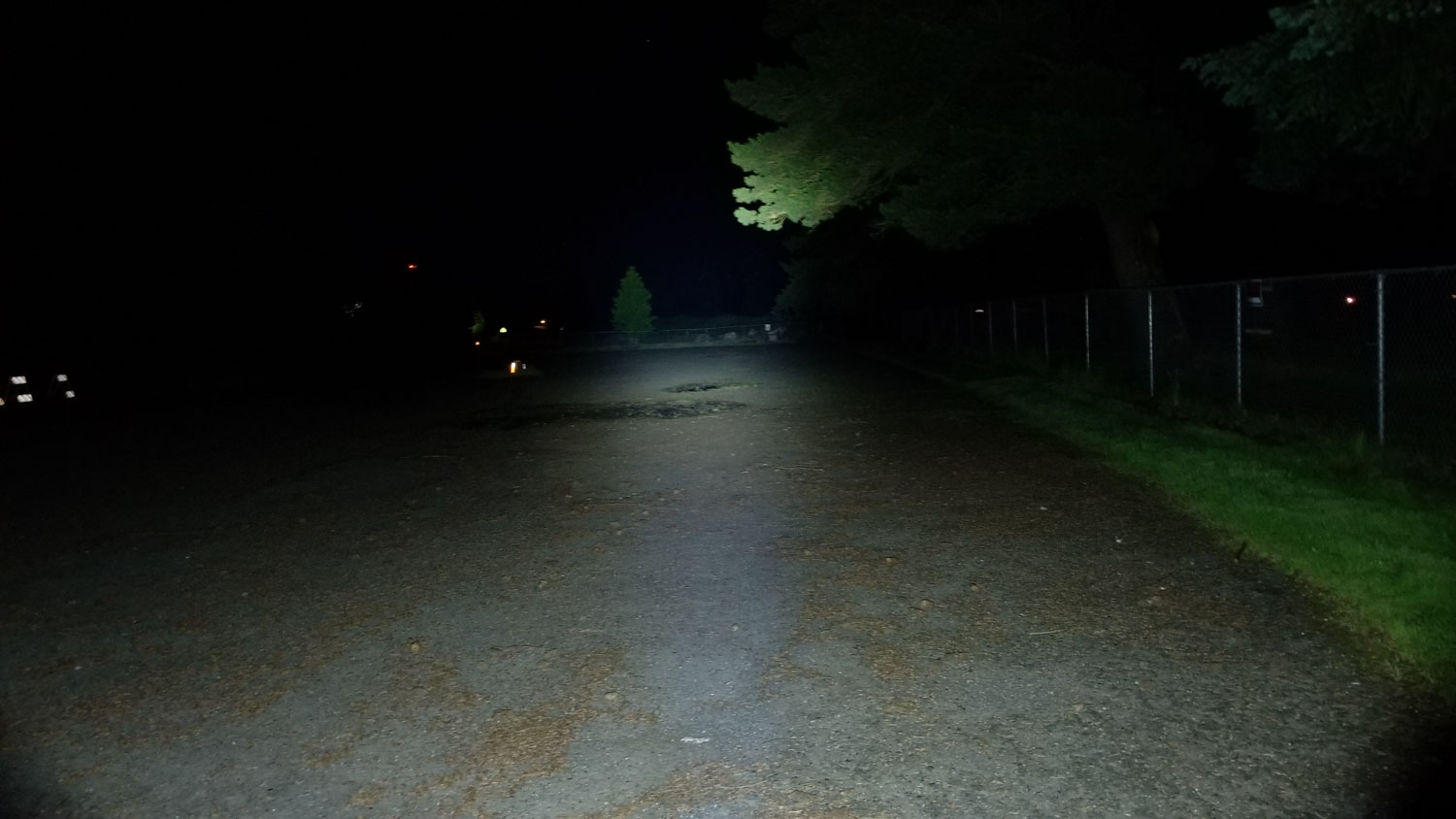





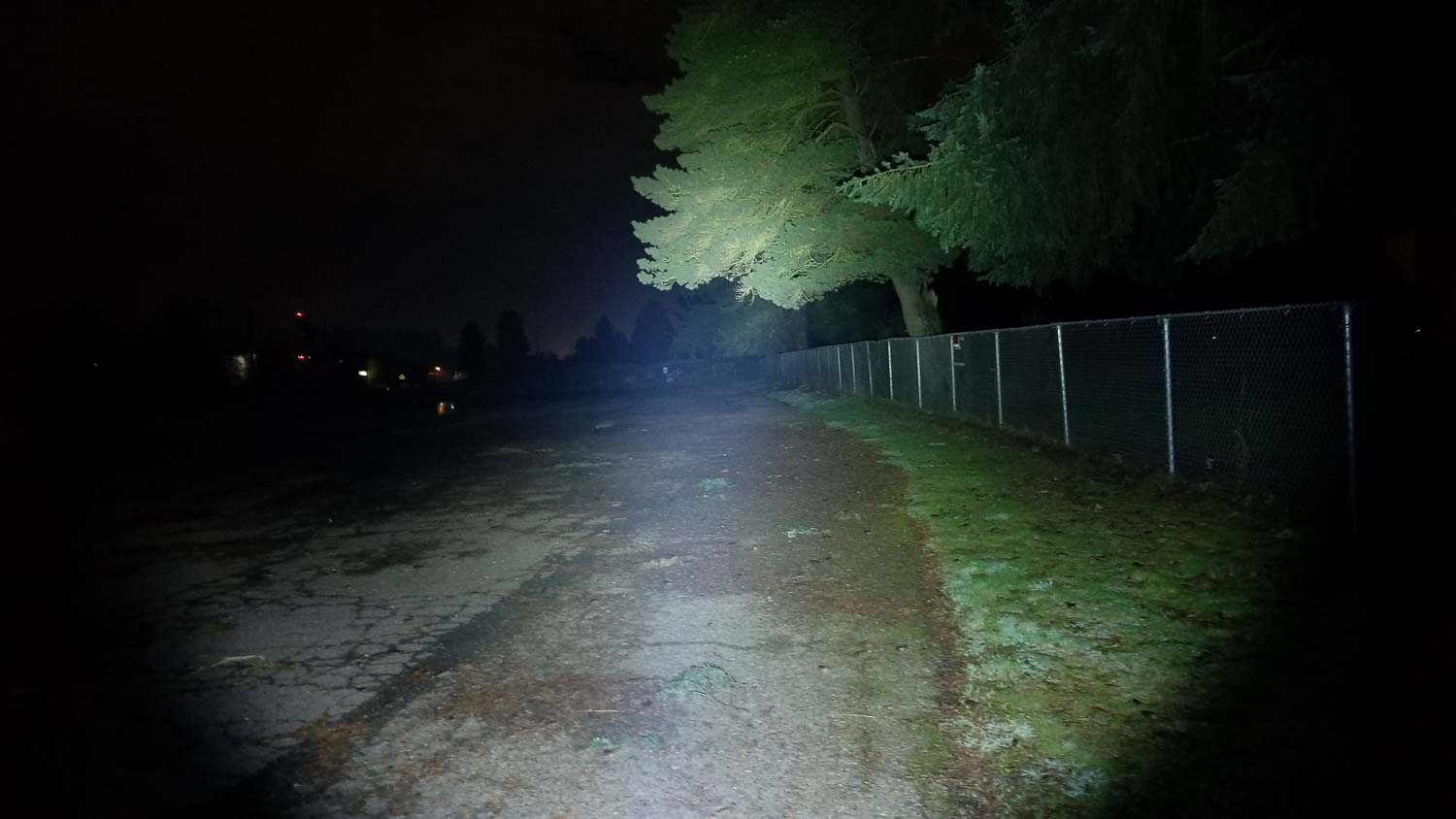
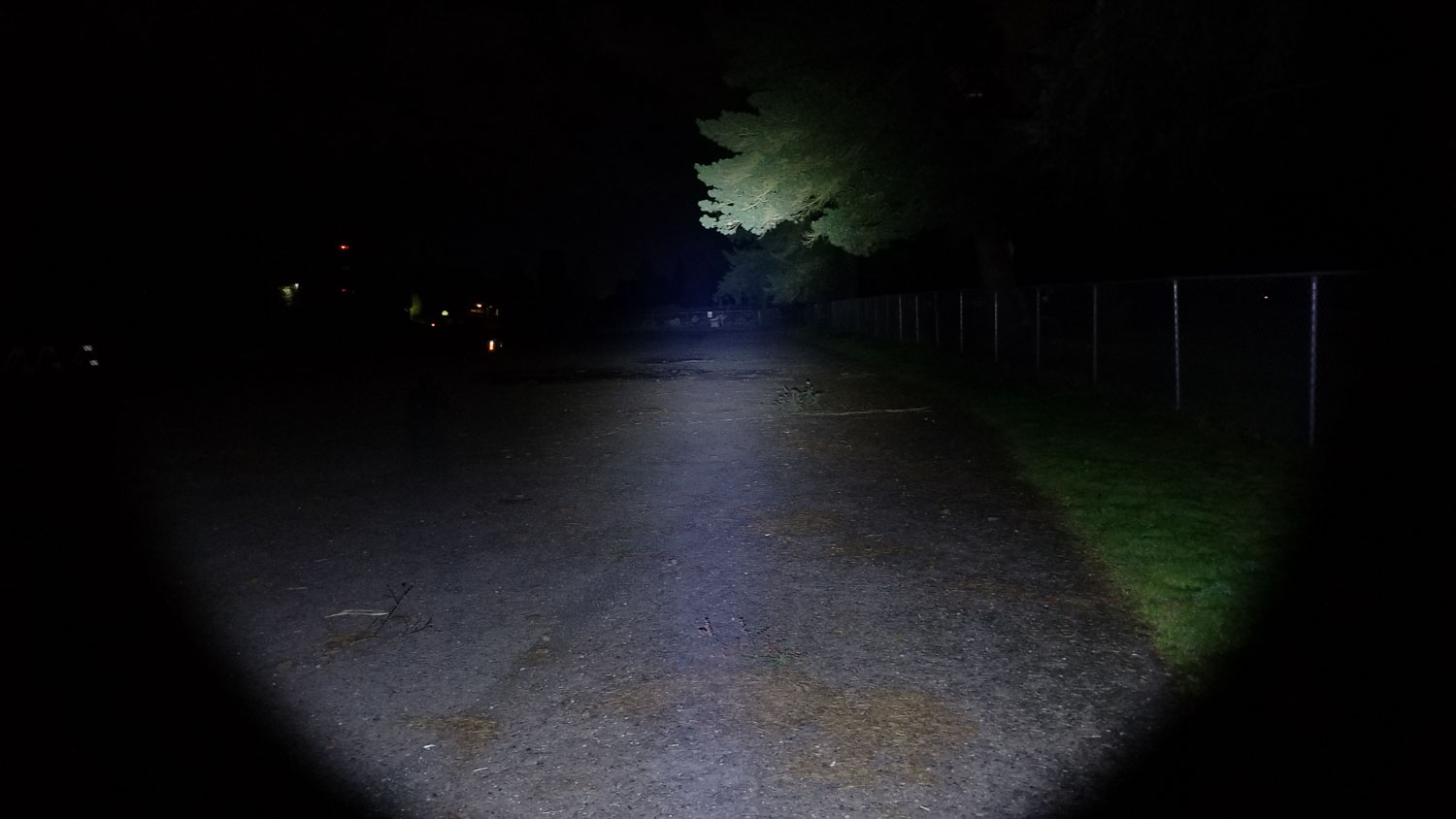
Disclaimer: This flashlight was sent to me for review at no cost by Fenixlighting. I have not been paid to review, nor have I been holding back on problems or defects.
Final Verdict
Pros
- Solid build quality
- Excellent quality, fit and finish
- Lightweight
- Simple UI
- Nicely regulated buck driver
- Can use CR123A batteries
Cons
- Expensive
- No battery included
- Limited to button top cells
- Switch takes getting used to
- No onboard charging
- A bit long for an EDC
Explanation on star ratings:
1: Avoid: my phone flashlight would be a better choice – 2: Poor: significant defect or issues; almost unusable – 3: Average: some defects or issues; but still usable 4: Good: recommended (minor issues) – 5: Great: highly recommended

3.5 stars: ★★★⋆
There are tons of EDC options out there and with so many great choices out there, it begs the question: Where does the PD32 V2 fit in? I had to think long and hard about that because there’s a few problems with this light. Don’t get me wrong, it brings to the table everything I expect from Fenix with excellent build quality, fit, finish, and a nicely regulated buck driver.
You also get solid performance, especially the excellent throw figures it put up. I also really liked the simple, intuitive UI. Although the output is nothing to write home about, not having onboard charging is a bit annoying for a mainstream flashlight in 2022.
However, that doesn’t bother me as much as the missing battery because that could be a potential deal-breaker for someone looking for a ready-to-run light that doesn’t own a button top 18650 and charger or an 18650 with built-in charging. Those would be additional purchases and add cost to an already pricey light.
Fenix, if you’re reading this, please include an 18650 with built-in charging. The switch took some acclimating due to the odd feel and lack of feedback and clicks, but I like the fact you have a momentary operation with it, and Strobe is hidden. There’s so many excellent EDC options these days, and part of me feels like the PD32 V2 is a duty light pretending to be an EDC and I think it would appeal to security personnel, police departments, or first responders with access to CR123A batteries looking for something smaller (only slightly so) and more pocketable than a full-size 21700 light. It’s a good light, but it’s hard to give the PD2 V2 more than 3.5 stars.
Fenix PD32 v2 For Sale:
Get 10% off every purchase at Fenix Lighting US, by using our exclusive 1lumen discount code: 1lumen10
1lumen selects and reviews products personally. We may earn affiliate commissions through our links, which help support our testing.